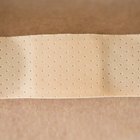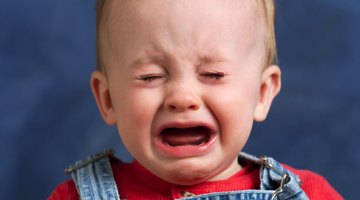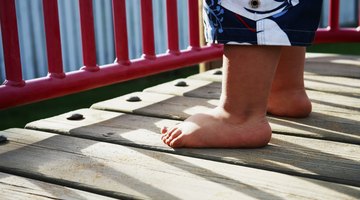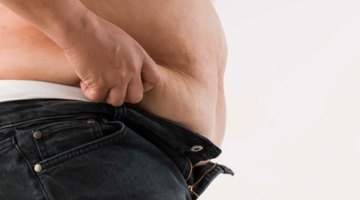Broken Collarbones in Toddlers
The collarbone, or clavicle, is the bone children break most often. Although a broken collarbone may signal child abuse or neglect, it's more commonly the result of a normal, rambunctious toddler's activities. Because very young children may not be able to vocalize their pain, knowing the symptoms of a broken collarbone may help you recognize an injury in your toddler.
Definition
The collarbone is a long bone in the shoulder that connects the rib cage to the shoulder blade, or scapula. The bone's length makes it vulnerable to breaks near the middle, but some breaks occur where the bone attaches to the rib cage or scapula.
Causes

How to Heal a Toddler's Scraped Nose
Learn More
Toddlers most often fracture or break their collarbones when they fall down with their hands outstretched toward the ground. A fall directly on the tip of the shoulder can also break a collarbone. Nerves and blood vessels are present under the collarbone, but they are not often damaged if the collarbone suffers trauma. Sometimes the bone will make a popping sound when it breaks, but often you won't know it's broken until the toddler shows some other symptoms.
Symptoms
A small child who doesn't want to move his arm or who keeps his arm close to the side of his body may have broken his collarbone. If you pick a toddler up under her arms and she cries out, or if you see a bump, bruise or swelling on the collarbone, suspect a break. Other symptoms include the toddler's inability to lift his arm or a "grinding" feeling when he tries to raise his arm. A few days to a week after a break, the collarbone forms a lump, also called a callus, where the break is healing. If the toddler has not displayed any symptoms of a broken collarbone, sometimes this callus is the only indication of a break.
Diagnosis

My Baby Hit His Head: What Should I Do?
Learn More
A doctor must diagnose a broken collarbone. He may ask questions about how the injury happened, apply gentle pressure to the site of the suspected break and order an X-ray. The doctor wants to ensure that none of the blood vessels or nerves sustained any damage, and he'll need to determine the exact location of the break and whether the ends of the bone are displaced or not.
Treatment
A broken collarbone with the ends of the bones still lined up usually heals without the toddler's needing surgery. The doctor will apply a sling or wrap to stabilize the arm, and she'll prescribe pain medication if needed. If the ends of the bone are displaced, a surgeon may insert screws and plates to line the bone up so it will heal correctly. Once the injury has healed, the doctor may prescribe physical therapy to strengthen a shoulder that has weakened or stiffened due to the toddler's wearing a sling for an extended period.










